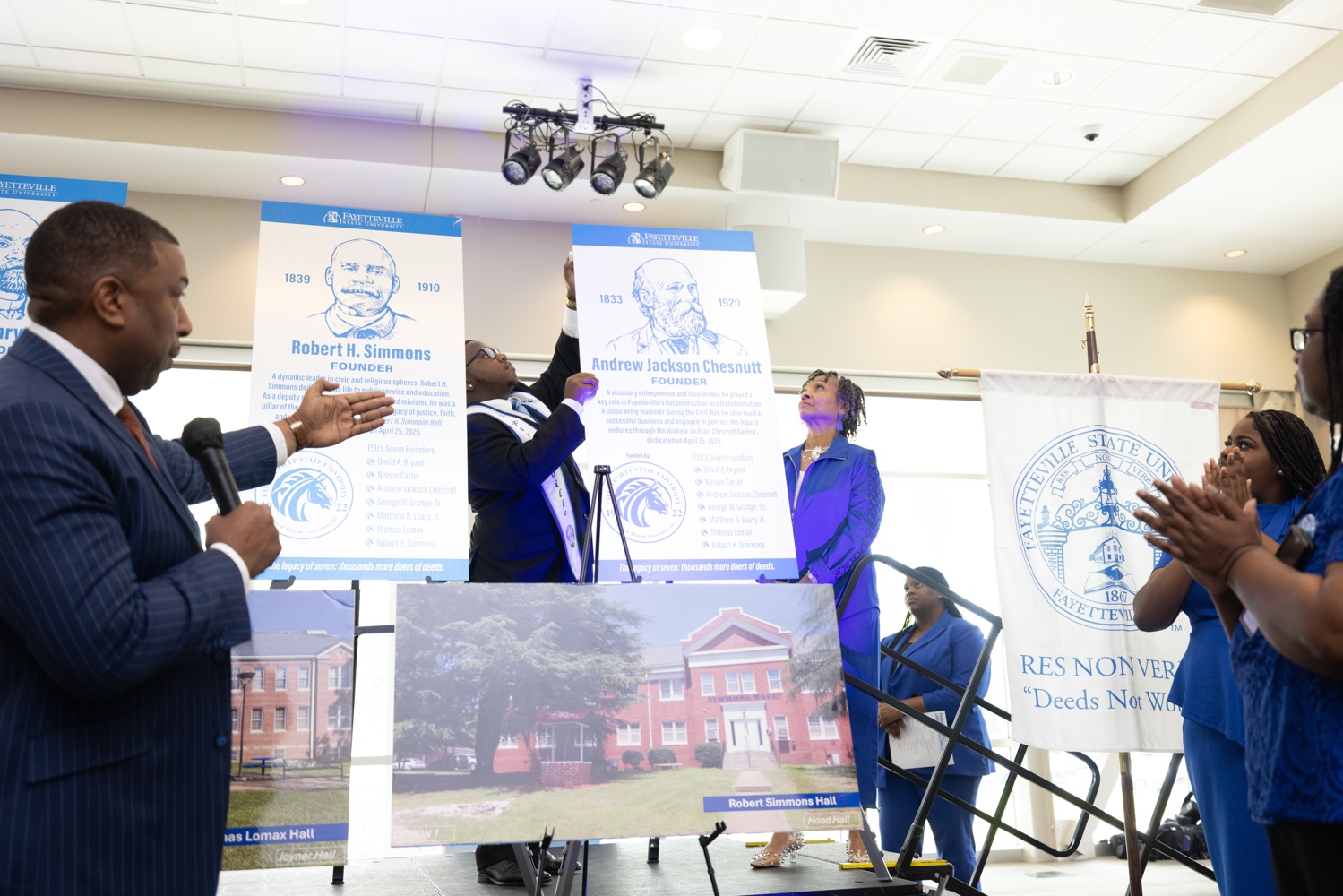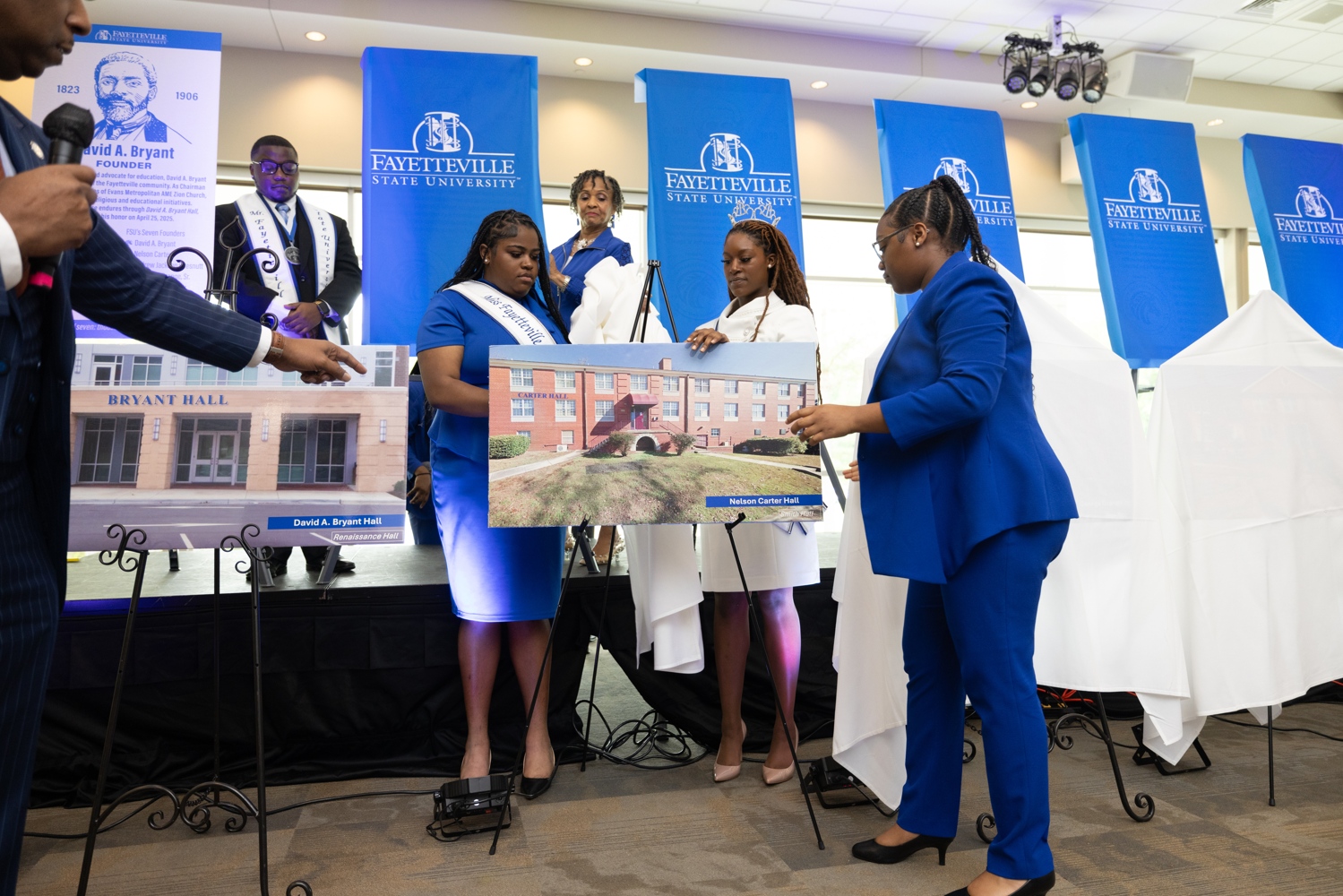Founders’ Legacy & Landmarks Celebration

FAYETTEVILLE, N.C. — In a historic and emotional ceremony, Fayetteville State University (FSU) commemorated its seven founders during the Founders’ Legacy & Landmarks Celebration held on April 25, 2025, at the Rudolph Jones Student Center. The event marked the official renaming of six campus residence halls and the establishment of a new gallery, ensuring that the names and contributions of FSU’s founders will endure for generations to come.
Chancellor Darrell T. Allison, who first introduced the initiative in 2024 in collaboration with the FSU National Alumni Association, led the celebration alongside Masters of Ceremonies Mr. Omar Bell, Vice Chancellor for University Advancement, and Dr. Juanette Council, Vice Chancellor for Student Affairs.
“This day marks a sacred and long overdue moment,” Chancellor Allison said. “Today, we will permanently erect their names into spaces where students will live, learn, and lead. We are providing a final resting place for these seven founders; their names will rest in perpetuity on these buildings.”
The project includes renaming six residence halls after six of the seven founders. The seventh founder, Andrew J. Chesnutt, will be honored by establishing the Andrew J. Chesnutt Gallery on the fourth floor of the Charles W. Chesnutt Library. Charles was Andrew’s son, making this recognition deeply meaningful.
The updated building names are as follows:
- David A. Bryant Hall (formerly Renaissance Hall, constructed in 2012)
- Nelson Carter Hall (formerly Smith Hall, constructed 1953)
- George Grange Sr. Hall (formerly New Residence Hall, constructed 1977)
- Matthew Leary Jr. Hall (formerly Harris Hall, constructed 1938)
- Thomas Lomax Hall (formerly Joyner Hall, constructed in 1930 and FSU’s oldest building)
- Robert Simmons Hall (formerly Hood Hall, constructed 1939)

Each renamed building will feature the founder’s name on the exterior and an interior plaque detailing their legacy. Campus directional signage will also be updated to reflect the new names.
Kimberly Jefferies Leonard, Chair of the FSU Board of Trustees and a proud member of the Class of 1986 emphasized the occasion’s lasting significance. “The names of these buildings and landmarks will now be synonymous with the legacy of Fayetteville State University and our founders,” Leonard said.
The celebration included heartfelt greetings from several community leaders, including The Honorable Kathy Jensen, Mayor Pro Tem for the City of Fayetteville, who shared a personal connection to FSU through fond memories of attending her first college football game there. Vice Chair of the Cumberland County Board of Commissioners, The Honorable Veronica Jones, FSU SGA President Ms. Johnae Walker, and FSU National Alumni Association, Inc. President Mrs. Linda Coley (Class of 1974) also offered remarks.
A highlight of the event was the participation of more than 120 descendants of the seven founders, each family offering reflections on their ancestors’ enduring impact. Dr. Doris Hughes-Moore, a descendant of founder Matthew Leary, spoke on behalf of her family. “Although we can’t remain here, our history can remain here,” Hughes-Moore said. “We cannot ever let anyone bury our history.”
The musical talents of the FSU Choir, directed by Detra Davis and Temoni Agee-Boyce, added to the spirit of reverence and pride that filled the Student Center.
The program concluded with heartfelt closing remarks from The Honorable Glenn Adams, J.D., FSU Board of Trustees Vice Chair and Cumberland County Commissioner, who underscored the historic significance of the day and the importance of maintaining the founders’ vision as a guiding light for future generations.
The Founders’ Legacy & Landmarks Celebration not only honored FSU’s past but also reaffirmed the university’s ongoing commitment to remembering and elevating the courageous individuals who invested $136 in 1867 to create an educational haven for Black children in the aftermath of the Civil War, a bold act of vision and hope that continues to inspire generations.
